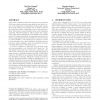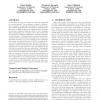WWW
2011
ACM
13 years 6 months ago
2011
ACM
Recently, a number of algorithms have been proposed to obtain hierarchical structures — so-called folksonomies — from social tagging data. Work on these algorithms is in part ...
WWW
2011
ACM
13 years 6 months ago
2011
ACM
Existing enterprise calendaring systems have suffered from problems like rigidity, lack of transparency, and poor integration with social networks. We present the system design an...
WWW
2011
ACM
13 years 6 months ago
2011
ACM
We investigate the problem of learning to rank for document retrieval from the perspective of learning with multiple objective functions. We present solutions to two open problems...
WWW
2011
ACM
13 years 6 months ago
2011
ACM
Query auto completion is known to provide poor predictions of the user’s query when her input prefix is very short (e.g., one or two characters). In this paper we show that con...
WWW
2011
ACM
13 years 6 months ago
2011
ACM
In this work, we study the notion of competing campaigns in a social network. By modeling the spread of influence in the presence of competing campaigns, we provide necessary too...
WWW
2011
ACM
13 years 6 months ago
2011
ACM
Measuring the causal effects of online advertising (adfx) on user behavior is important to the health of the WWW publishing industry. In this paper, using three controlled experi...
WWW
2011
ACM
13 years 6 months ago
2011
ACM
WWW
2011
ACM
13 years 6 months ago
2011
ACM
Gradient Boosted Regression Trees (GBRT) are the current state-of-the-art learning paradigm for machine learned websearch ranking — a domain notorious for very large data sets. ...
WWW
2011
ACM
13 years 6 months ago
2011
ACM
Social hierarchy and stratification among humans is a well studied concept in sociology. The popularity of online social networks presents an opportunity to study social hierarch...
WWW
2011
ACM
13 years 6 months ago
2011
ACM
We analyze the information credibility of news propagated through Twitter, a popular microblogging service. Previous research has shown that most of the messages posted on Twitter...


